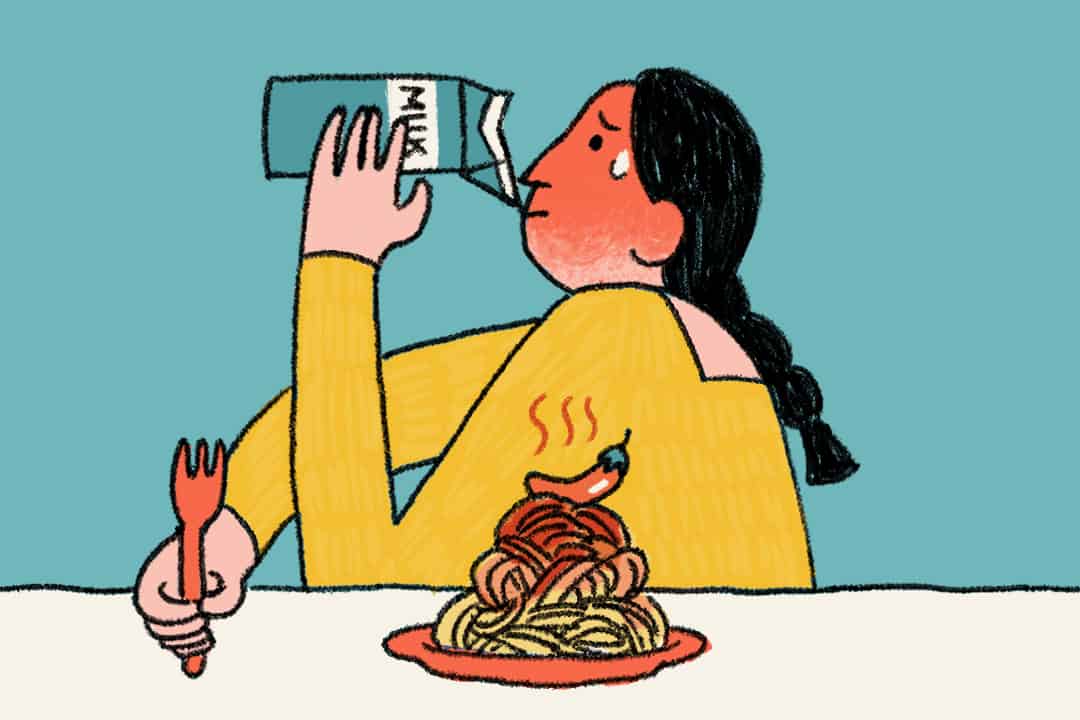If you’re a fiend for hot foods and can’t resist a spicy meal, you’re probably no stranger to the burning sensation that comes afterward. Your mouth is on fire, you can’t taste anything else, your nose is running — and then your friend offers you a glass of water. Maybe you’ve heard others recommend drinking milk or eating sugar instead in order to alleviate the pain — but do these seemingly unrelated methods really work? And if they do, why?
The biochemistry of “tasting” spicy food
The active component of most spicy food is called capsaicin. It is directly responsible for the burning sensation you experience on your tongue after having spicy food like chilies or hot sauce. Capsaicin binds to a type of receptor on your tongue called the transient receptor potential vanilloid type 1 (TRPV1). When capsaicin binds TRPV1, calcium ions rush into the cells on your tongue, and signals are sent through your neurons that classify the sensation as “spicy.” It is the capsaicin-induced activation of this TRPV1 receptor that induces the feeling of heat burn. There is no physical heat involved, though, as this heat is a chemical taste illusion.
How to fight off capsaicin: Most to least effective methods
Picture this: you are having spicy food and you drink water, but the water is not doing anything. A molecule that separates capsaicin from TRPV1 would alleviate the burning sensation, but capsaicin is a hydrophobic and fat-soluble molecule, meaning it repels water and dissolves in fats. Therefore water is minimally effective at alleviating the burn.
There are two main theories on why popular remedies like milk work in fighting off spice. First, milk contains hydrophobic protein molecules called casein. As we’ve all learned in chemistry class, like dissolves like, so if hydrophobic casein is available, capsaicin will detach off of the TRPV1 receptor and bind to casein instead. This means that fewer TRPV1 receptors on your tongue are engaged by capsaicin, and the burning sensation is reduced. The second theory is that because capsaicin is fat-soluble, the fat content of milk dissolves it, which limits capsaicin from binding to TRPV1.
In general, the most effective way to fight off capsaicin is by having casein-containing milk with the highest fat content you can find.
If you take your lactose intolerance seriously, there are other options for you! Capsaicin is alkaline, which makes it basic. This means it can be neutralized by acids, so lemon juice, vinegar, or any other acidic food or additive also works. This method is less effective than milk though, because milk strips away capsaicin from its receptor by offering a more alluring alternative, whereas acids act to neutralize capsaicin itself, without disengaging it from the TRPV1 receptor.
As for the suggestion to eat bread to fight off spiciness, it is important to note that carbohydrates are not helpful from a chemical standpoint. Rather, bread is recommended because it acts as a barrier between the capsaicin molecules and the TRPV1 receptors on your tongue.
My recommendation, though, is to just stop having spicy food altogether. Is it really worth the pain?
Editor’s note (October 1): A previous version of this article incorrectly stated that the activation of the TRPV1 receptor induces ‘heartburn’ instead of ‘heat burn.’


